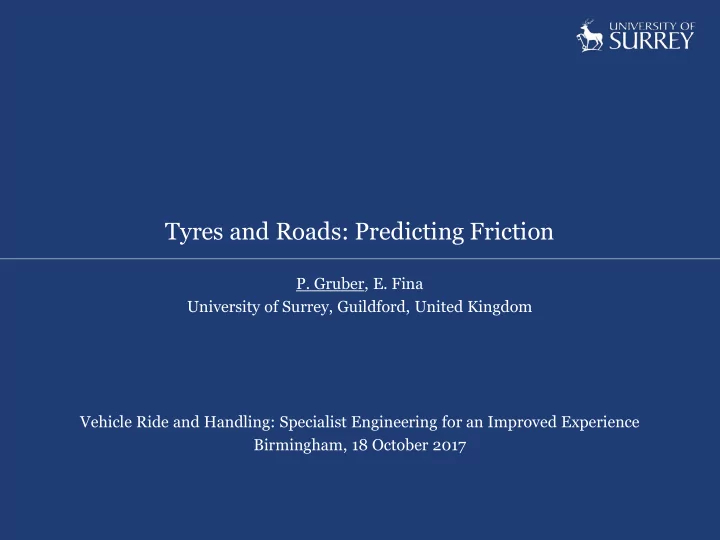

Tyres and Roads: Predicting Friction P. Gruber, E. Fina University of Surrey, Guildford, United Kingdom Vehicle Ride and Handling: Specialist Engineering for an Improved Experience Birmingham, 18 October 2017
Overview • Tyre characteristics and importance of friction • Measurement of friction • Physical-based friction modelling • Friction results and tyre simulations • Future work 2
Tyre characteristics Importance of friction
Tyre characteristics (1) Velocity and surface characteristics (Bachmann, 1998) → tyre force ( µF z ) more and more influenced by rubber friction µ reduces with increasing velocity → temperature effect → slip stiffness primarily influenced by elastic tyre properties 4
Tyre characteristics (2) Generic force against slip curve (pure slip) sliding region adhesion region force (sliding region) force (adhesion region) 5
Tyre characteristics (3) Surface characteristics (Hüsemann, 2010) → µ changes with road surface texture 6
How to measure rubber friction?
Friction measurement (1) Parameters Tyre forces are functions of: • normal load • surface nature and texture • rubber compound • rubber temperature • surface temperature • sliding speed Fundamental experiments by Grosch in 1963 Established relationship between: • rubber properties • surface roughness • friction 8
Friction measurement (2) Grosch experiments (1963) F z F friction V temperature speed-controlled motor controlled enclosure (low velocities to avoid heating) (-50 ° C to 100 ° C) silicon carbide paper (also wavy glass) force measurement static load on test rubber block 9
Friction measurement (4) Grosch results (1963) - Master friction curve • Combining temperature and sliding velocity by Williams, Landel, Ferry (WLF) transform gives master curves T range: -15 ° C to 80 ° C T 0 = 20 ° C WLF transform 8 . 86 T T S log 10 a T 101 . 5 T T S • A change in temperature can be treated as a change in sliding velocity 10
Friction measurement (3) Grosch results (1963) SBR at 20 0 C rough surface (silicon carbide) smooth surface (wavy glass) rough surface ‘without direct contact’ (powdered silicon carbide) Peak friction values appear to coincide: • with excitation of rubber at loss tangent peak for rough surfaces → Deformation/hysteresis friction • with excitation of rubber at loss modulus peak for smooth surfaces → Adhesion friction 11
Physical-based friction modelling Approach and results 12
Concept Klüppel & Heinrich (~2000) and Persson (~2001) Rubber Surface properties roughness (DMA) constant temperature Friction theory: hysteresis/deformation + adhesion friction, calculate area, temperature Friction coefficient 13
Friction theory basics Persson’s deformation theory • μ , friction coefficient • C(q), road spectral density function • P(q), contact area ratio – actual/nominal • q 0, q 2 , wavenumbers for longest and shortest waves • T q , temperature • G, rubber complex shear modulus; , Poisson’s ratio • • v, sliding velocity • σ z , nominal normal stress • superposition of energy-loss contributions from shortest to longest waves → longest wave ( q 0 ) non-critical; shortest wave (q 2 ) needs estimating • rubber treated as linear viscoelastic (amplitude not considered) rubber V λ L complex surface 14
Comparison Grosch experiments simulated with Persson’s theory • With favourable treatment, rough- surface friction peak realistic with respect to Grosch • Below peak, adhesion can account for differences • Above peak, predicted friction falls too much as sliding speed increases Fina E, Gruber P, Sharp RS. (2014) 'Hysteretic Rubber Friction: Application of Persson's Theories to Grosch's Experimental Results'. JOURNAL OF APPLIED MECHANICS-TRANSACTIONS OF THE ASME , 81 (12) Article number ARTN 121001 15
Simulation results Standard and racing compounds 16
Friction Results (1) Influence of compound and temperature – constant temperature No frictional heating Increasing temperature Standard: Lorenz et al., Rubber friction for tire tread compound on road surfaces. Journal of Physics: Condensed Matter, 25(9):095007 Racing: Formula Student Hoosier racing tyre 17
Friction Results (2) Influence of compound and temperature – constant sliding speed, 1 m/s v = 1 m/s Standard: Lorenz et al., Rubber friction for tire tread compound on road surfaces. Journal of Physics: Condensed Matter, 25(9):095007 Racing: Formula Student Hoosier racing tyre 18
Tyre model results Friction model included in tyre model Tyre Local mechanics/ thermal contact Tyre forces Input model & moments parameters patch Friction model Global thermal model 19
Tyre model results Friction model included in tyre model – traction test Standard FS Hoosier (Lorenz et al., racing compound 2013) 20
Friction results (3) Influence of road surface texture Stowe Vale (resurfaced) 21
Friction Results (4) W Influence of surface texture – contact patch during cornering test leading leading trailing centre trailing centre edge edge edge plane edge plane 22
Conclusions and future work 23
Conclusions Friction theories • Rough surface friction – deformation; Persson’s hysteresis mechanics plausible • Smooth surface friction – adhesion, not well understood Open questions • Surface roughness > contributions of wavelengths • Largest wavelength non-critical • shortest wavelength uncertain, influenced by cleanliness and debris Which q 2 to use? • Rubber treated as linear viscoelastic material • Amplitude dependence Which properties to use? More measurements and validation required 24
Future work (1) Test rig at University of Surrey Normal load applied through weights 3 axis force sensor Rubber block Test surface Linear actuator Linear rail system • Direct-drive linear motor to support surface • ~1 µm/s to 5 cm/s • Max. force 153N Weights Dynamic climate test chamber • -40°C to 180°C • compressed air dryer 25
Future work (2) Test rig at University of Surrey 26
Future work (3) Test rig at University of Surrey 27
Recommend
More recommend